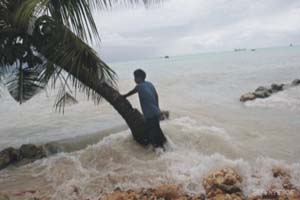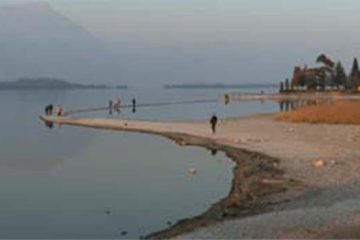Dr Moazzem Hossain
 It is now widely recognised that the coastal regions of the world would suffer severely both in economic and social fronts from the direct impact of global warming and rising sea level. It has been noticed that in recent years sea-level rise, frequent storms and cyclones, and riverbank erosion have taken a serious turn in the coastal regions of the Bay of Bengal. These necessitate checking up vulnerability of the coastal people. In particular, investigation on the livelihood in terms of socio-economic vulnerability (risk) of the coastal population is of paramount importance. Two initiatives are urgent: one, investigating the types of adaptation measures available to overcome the economic and social devastation from frequent and extreme climatic hazards locally and nationally; two, measuring the socio-economic vulnerability of the frontline coastal regions for policy purposes.
It is now widely recognised that the coastal regions of the world would suffer severely both in economic and social fronts from the direct impact of global warming and rising sea level. It has been noticed that in recent years sea-level rise, frequent storms and cyclones, and riverbank erosion have taken a serious turn in the coastal regions of the Bay of Bengal. These necessitate checking up vulnerability of the coastal people. In particular, investigation on the livelihood in terms of socio-economic vulnerability (risk) of the coastal population is of paramount importance. Two initiatives are urgent: one, investigating the types of adaptation measures available to overcome the economic and social devastation from frequent and extreme climatic hazards locally and nationally; two, measuring the socio-economic vulnerability of the frontline coastal regions for policy purposes.
Adaptation approaches
The devastating impact of climate change on developing countries is widely recognised (IPCC 2007; Stern 2006; World Bank 2006; Sachs 2008). It is also recognised that social, economic and institutional considerations are central to the adaptation to climate change impacts in any part of the world, regardless of sector, location, or social group concerned. Efficient and effective action to avoid impacts from climate change requires local level knowledge on vulnerability such as employment, health and the natural environment. It also requires information about what actions are needed to avoid these impacts, including their costs, potential effects on livelihood, places, industries, future generations and the institutional barriers to implement adaptation measures (Hossain et al 2011, Climate Change and Growth in Asia).
In Cancun 2010, Someshwar of Columbia University, a leading scholar on adaptation, argued that studies on adaptation have so far contributed towards a general description of climate change impacts and called on the international community for assistance towards adaptation and mitigation (Copenhagen Summit 2009 in mind). The general description on impacts at regional or smaller scale based on global climate model cannot be a sound approach for policy purposes. It is now abundantly clear from the Copenhagen (2009) and Cancun (2010) summits that national policy makers in developing countries have been starved of specific evidence on the impacts of climate change at national and sub-national levels, thus lacking credible estimates on the vulnerabilities of communities to climate hazards such as cyclones, sea-level rise, floods, riverbank erosion and so on.
Measuring vulnerability
The literature on measuring vulnerability is, if not vast in the field of development, a widely researched area by geographers, health economists and medical statisticians. There are various ways the environmental vulnerability concept has been defined. According to QK Ahmad, a leading climate change expert and government advisor, vulnerability is the degree to which a natural or human system is susceptible or unable to cope with adverse effects of climate change including climate variability and extremes. In fact, vulnerability varies from region to region, country to country, or even between different parts of a country (Hossain et al 2011). Someshwar (2008) suggests that, the approach adopted by the IPCC to determine the long term impact of climate change for countries has been based on deterministic projections of impacts, and general statements about the need for sustainable development. No specific actions had been presented in the IPCC’s approach such as what investments are required to manage which aspects of climate risk that are likely to impact who and where? The outcome of these estimates has been too generic. It seems clear that additional venues will need to be explored to help developing countries formulate adaptation policies and programs that are contextualised in place, time and development risk, Someshwar further argues. Both Ahmad and Someshwar conclude that vulnerability measurement based on local level data is important for making informed adaptation policies. The author of this piece is presently involved in measuring vulnerability in three Asia-Pacific regions with three approaches: Environmental Vulnerability Index (EVI), Vulnerability as Expected Poverty (VEP) and combination of EVI and VEP.
Government initiatives
Given the circumstances of various nations, the resource poor or income poor countries which include 25 least developed nations are particularly vulnerable to extreme climatic hazards induced by global warming. Copenhagen 2009 Accord finds Bangladesh as one of the most vulnerable nations to climate change. Thus, this nation is one of the main contenders for the Copenhagen/Cancun Green Fund. Concurrently, Bangladesh government established its own adaptation fund known as Climate Change Trust Fund. Currently, the government has contributed from its own resources Tk1,400 crore to this Fund. Recently, the Trust Fund allocated some money to the selected government and the NGO led adaptation projects. It appears that some sections of the media have been criticising the selection process and their scrutiny has been centred on two major issues: one, the government led projects have been provided with large sums of funds as against the projects led by NGOs (it has also been claimed that some NGOs have no credible background) and two, accountability measures over the project implementation period has remained unclear.
While the selection process followed by the Trust Fund in this round seems transparent, the accountability measures in place have been remained obscured. It must be ensured upfront that, the new initiatives do not invite any controversy for the Trust Fund or for the recipients, locally and internationally. Since the government managed projects attracted large sums, accountability in managing these projects in particular must be ensured by the Trustees. The idea of making district civil administration largely responsible for acting as a watch dog while understandable, unfortunately, in the past, the civil administration playing such a role in the development area had credibility problem. Certainly, climate change adaptation management style needs innovative and popular participation to ensure accountability and universal acceptability of projects.
In concluding, it is important to remember that, the government’s new initiatives at local level will be observed closely, domestically and internationally. While the adoption of place-based adaptation approach by the government deserves applause, the implementation process needs to be kept free from all sorts of irregularities: economic, bureaucratic and political.
Dr Moazzem Hossain is principal editor of the volume, Climate Change and Growth in Asia, published by Edward Elgar, UK, 2011



